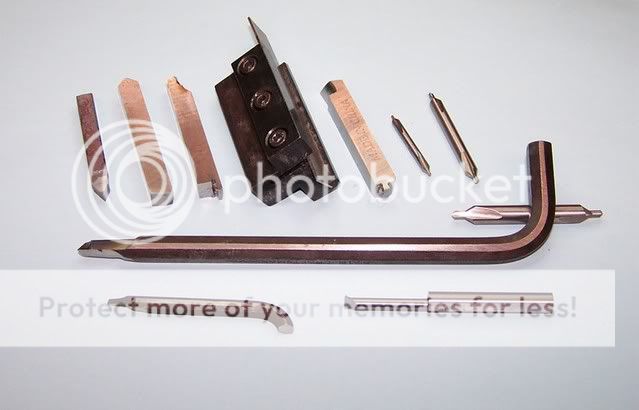tino_ale
Flashlight Enthusiast
Hi all,
The more time passes, the more I just can't get used to the idea of not having a lathe. Having ideas but no mean to accomplish them is just plain frustrating Not only about flashlights, but many other little parts that I would like to make.
Not only about flashlights, but many other little parts that I would like to make.
Anyway, here is the website for these Wabeco machines : http://www.wabeco-remscheid.de/
They are distributed in the US by MDA precision , haven't found them in France yet, but they are made in Germany so I guess it should be doable...
These machines are expensive. Too expensive some may say in regards to their size... but they seem to offer precision and quality works from a very small (bench top) form factor. This has a price apparently!
I personnally can't keep a big machine. I may very well end up using my lathe in a reserved room of an appartment. :huh: I don't need it to be small to the point where I would move it alone, or put it back in a shelf when not in use... (I'm not looking for a micro lathe) But I needs to be no more than 250 lbs or so... movable by 3 people.
Of course I'm considering cheaper lathe too, like the LM 8x14 which sounds like the best cheap chinese out there.
My problem is that to my little knowledge, there is nothing between a chinese 8x14 and these german refined machines. Keep in mind the form factor. There is a huge gap in both price and built quality.
I got a couple of question, if someone can help :
- Do you think the D2000/D4000 are large enough to comfortably work on up to 2D mag (exterior work only) and D mag heads. They have about 13" between centers.
- How do you think the D2000 compare to the D4000? The D2000 have tubes instead of prismatic bed, I don't how good this system is? and how well it will remain precise over time? Besides, the price difference is not that huge... Would it be wise to choose the D4000 instead?
the important question :
- Do you know any other brand/model of reasonable sized lathe which offer better overall quality than the chinese, but cheaper than the german? Talking new machine here...
The LM 8x14 and the Wabeco machines sound like completely different offer, yet I have the dilema of which one to get. I've seen the cheap one can do amazing things, but I really need a hassle-free machine, more or less ready out of the box, and RELIABLE. Also I would like to machine parts that are not easy on the lathe : Titanium and stainless steel.
Cheap chinese or nice german... the german is tempting but I need to keep some funds for the tooling :duh2::ironic: .
Any help is appreciated
Thanks for reading!
The more time passes, the more I just can't get used to the idea of not having a lathe. Having ideas but no mean to accomplish them is just plain frustrating
 Not only about flashlights, but many other little parts that I would like to make.
Not only about flashlights, but many other little parts that I would like to make.Anyway, here is the website for these Wabeco machines : http://www.wabeco-remscheid.de/
They are distributed in the US by MDA precision , haven't found them in France yet, but they are made in Germany so I guess it should be doable...
These machines are expensive. Too expensive some may say in regards to their size... but they seem to offer precision and quality works from a very small (bench top) form factor. This has a price apparently!
I personnally can't keep a big machine. I may very well end up using my lathe in a reserved room of an appartment. :huh: I don't need it to be small to the point where I would move it alone, or put it back in a shelf when not in use... (I'm not looking for a micro lathe) But I needs to be no more than 250 lbs or so... movable by 3 people.
Of course I'm considering cheaper lathe too, like the LM 8x14 which sounds like the best cheap chinese out there.
My problem is that to my little knowledge, there is nothing between a chinese 8x14 and these german refined machines. Keep in mind the form factor. There is a huge gap in both price and built quality.
I got a couple of question, if someone can help :
- Do you think the D2000/D4000 are large enough to comfortably work on up to 2D mag (exterior work only) and D mag heads. They have about 13" between centers.
- How do you think the D2000 compare to the D4000? The D2000 have tubes instead of prismatic bed, I don't how good this system is? and how well it will remain precise over time? Besides, the price difference is not that huge... Would it be wise to choose the D4000 instead?
the important question :
- Do you know any other brand/model of reasonable sized lathe which offer better overall quality than the chinese, but cheaper than the german? Talking new machine here...
The LM 8x14 and the Wabeco machines sound like completely different offer, yet I have the dilema of which one to get. I've seen the cheap one can do amazing things, but I really need a hassle-free machine, more or less ready out of the box, and RELIABLE. Also I would like to machine parts that are not easy on the lathe : Titanium and stainless steel.
Cheap chinese or nice german... the german is tempting but I need to keep some funds for the tooling :duh2::ironic: .
Any help is appreciated
Thanks for reading!




